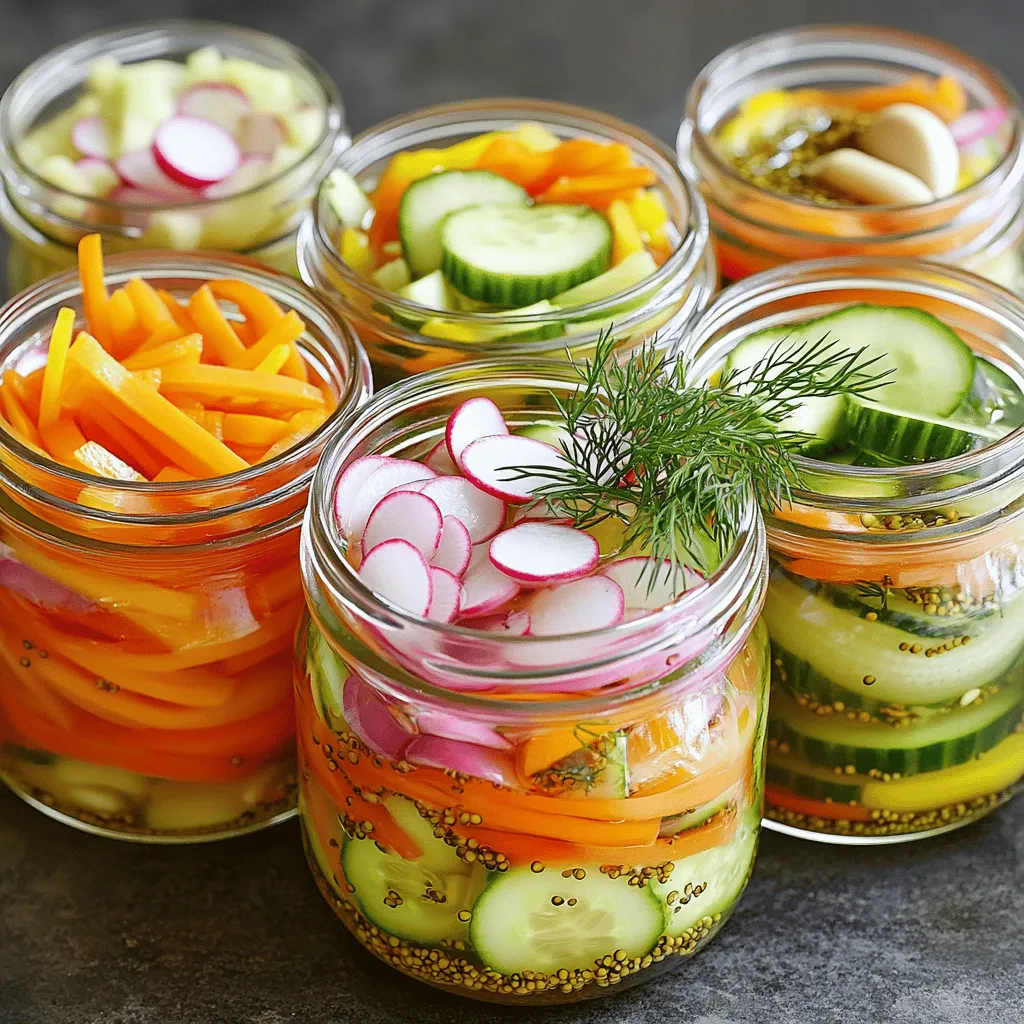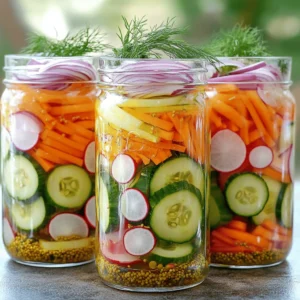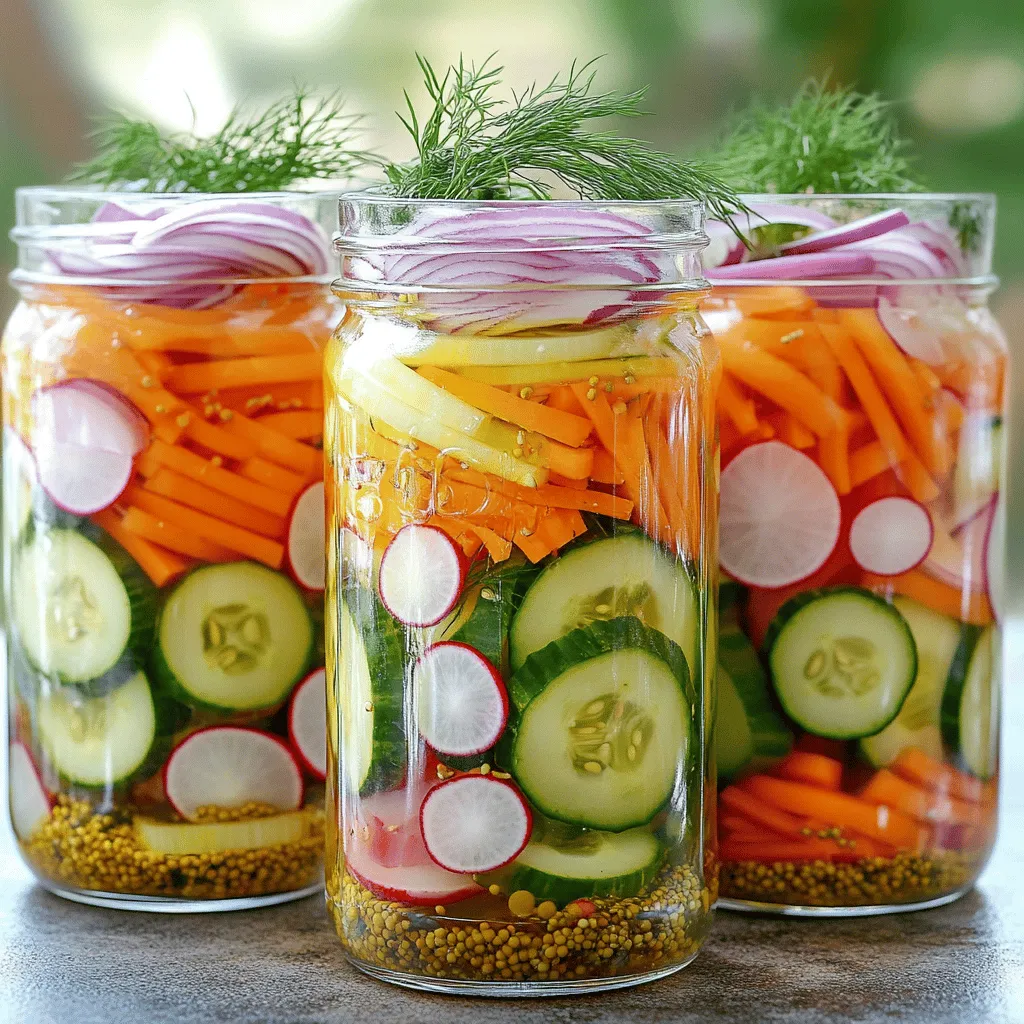Are you looking for a tasty and healthy snack option? Pickled vegetables are the perfect choice! They are crunchy, tangy, and packed with nutrients. In this guide, I’ll share everything you need to know about making your own vibrant pickled veggie medley. You’ll learn the best ingredients, step-by-step instructions, tips for success, and even fun variations. Get ready to enjoy a delightful and nutritious snack!
Ingredients
List of Ingredients for Vibrant Pickled Veggie Medley
To make my vibrant pickled veggie medley, gather these fresh ingredients:
– 1 cup carrots, julienned
– 1 cup cucumbers, thinly sliced
– 1 cup radishes, thinly sliced
– 1 cup bell peppers (any color), thinly sliced
– 1 cup red onions, thinly sliced
– 2 cups water
– 1 cup apple cider vinegar
– 2 tablespoons granulated sugar
– 1 tablespoon sea salt
– 1 teaspoon mustard seeds
– 1 teaspoon coriander seeds
– 1 teaspoon black peppercorns
– 2 garlic cloves, smashed
– Fresh dill sprigs (optional, for added flavor)
Nutritional Benefits of Each Ingredient
Each ingredient in my pickled veggie medley brings unique health benefits:
– Carrots: Rich in beta-carotene and good for your eyesight.
– Cucumbers: Hydrating and low in calories, perfect for staying refreshed.
– Radishes: Packed with fiber, they help with digestion.
– Bell Peppers: High in vitamin C, which boosts your immune system.
– Red Onions: Contain antioxidants and add a nice crunch.
– Apple Cider Vinegar: Aids digestion and may help with weight control.
– Garlic: Known for its heart health benefits and flavor boost.
– Dill: Contains vitamins and offers a fresh taste.
Suggested Alternatives for Ingredients
You can swap ingredients based on your taste or what you have:
– Carrots: Try zucchini or yellow squash for a different flavor.
– Cucumbers: Use green beans for a crunchy option.
– Radishes: Turnips can give a similar bite with a different flavor.
– Bell Peppers: Substitute with jalapeños for some heat.
– Red Onions: Use shallots for a milder flavor.
– Apple Cider Vinegar: White vinegar works well too, though it tastes different.
– Garlic: Garlic powder can be used if fresh isn’t available.
These ingredients all work together to create a crunchy and tasty snack. You can find the full recipe to get started on this healthy delight!
Step-by-Step Instructions
Detailed Instructions for Making Pickled Vegetables
To make pickled vegetables, start by gathering all your ingredients. You’ll need carrots, cucumbers, radishes, bell peppers, and red onions. Combine water, apple cider vinegar, sugar, salt, and spices in a large pot. Heat this mixture over medium heat. Stir it until the sugar and salt dissolve.
Once it boils, take it off the heat. Let the brine cool for about 10-15 minutes. Meanwhile, prepare your vegetables. Slice them thinly and layer them in a large glass jar. Add fresh dill if you want extra flavor.
Now, pour the cooled brine over the veggies. Make sure they are fully covered. Press them down if needed. Seal the jar tightly and place it in the fridge. Wait at least 24 hours to let the flavors mix. For a deeper taste, let them pickle for 3-5 days.
Enjoy your vibrant pickled veggies as a snack or topping for dishes. Try this Full Recipe for a fun cooking adventure!
Important Notes on Timing and Temperature
Timing is key in pickling. Letting the brine cool is very important. If you pour hot brine over the veggies, they can become mushy. Always cool the brine for at least 10-15 minutes.
After sealing the jar, it needs at least 24 hours in the fridge. This allows the flavors to develop well. For best results, taste them after 3-5 days. The longer they sit, the more flavor they gain.
Tips for Layering Vegetables in the Jar
Layering your vegetables is fun and important. Start with harder veggies like carrots and radishes. Then add softer ones like cucumbers and bell peppers. This way, all vegetables get enough brine.
Fill the jar tightly, but don’t mash the veggies. Leave some room at the top for the brine. If you want more flavor, add dill or other herbs between layers. This makes each bite exciting and tasty.
Tips & Tricks
Expert Tips for Perfectly Pickled Vegetables
To achieve great pickled veggies, start with fresh ingredients. Choose vibrant colors for a stunning look. Use a mix of crunchiness and flavor. Slice your veggies evenly for a uniform texture. Here are some key tips:
– Use a clean jar: Always sterilize your jar to keep your pickles safe.
– Experiment with spices: Add spices like dill or cumin for extra flavor.
– Taste as you go: Adjust salt and sugar to suit your preference.
Common Mistakes to Avoid While Pickling
Many people make mistakes that can ruin pickled vegetables. Here are some pitfalls to avoid:
– Skipping the brine cooling: Always let the brine cool before adding veggies.
– Not pressing down veggies: Ensure all veggies stay submerged in the brine.
– Rushing the pickling time: Let them pickle for at least 24 hours for best taste.
Best Practices for Serving and Pairing Pickled Vegetables
Serve your pickled vegetables in a fun way. Here are some ideas:
– Colorful display: Use small bowls or clear jars for an eye-catching presentation.
– Snack ideas: Pair with cheese or crackers for a tasty treat.
– Add to meals: Use them as toppings on salads, tacos, or sandwiches.
These tips will help you enjoy your pickled vegetables to the fullest. For a delicious recipe, check out the Full Recipe for Vibrant Pickled Veggie Medley.

Variations
Different Vegetable Combinations for Pickling
You can use many veggies for pickling. Each one adds its taste and crunch. Some great options include:
– Carrots
– Cucumbers
– Radishes
– Bell peppers
– Red onions
– Cauliflower
– Green beans
Mixing these vegetables gives you fun flavors and colors. You can also try seasonal veggies. This helps you enjoy fresh tastes all year.
Flavor Enhancements (Spices, Herbs, etc.)
Spices and herbs are key to pickled veggies. They give your snacks a unique twist. Here are some great options to add:
– Mustard seeds for a hint of warmth
– Coriander seeds for a citrus flavor
– Black peppercorns for a touch of heat
– Bay leaves for a smooth taste
– Fresh dill or thyme for herbal notes
– Red pepper flakes for extra spice
You can adjust the spices to match your taste. A little experimentation can lead to exciting new flavors.
Quick Pickling Methods for Last-Minute Snacking
Short on time? No problem! Here are some quick pickling methods:
1. Quick Vinegar Pickle: Combine vinegar, salt, and sugar. Pour over sliced veggies and let sit for 30 minutes.
2. Microwave Pickle: Mix vinegar, sugar, and salt in a bowl. Microwave for 1-2 minutes. Pour over veggies and cool.
3. Refrigerator Pickle: Use the full recipe, but skip the cooling time. Just chill for an hour before snacking!
These methods let you enjoy pickled vegetables fast. They are perfect for last-minute cravings!
Storage Info
Best Storage Practices for Homemade Pickled Vegetables
Storing your pickled vegetables right helps keep them fresh. Use a clean glass jar with a tight lid. Make sure your vegetables are fully submerged in the brine. This prevents them from spoiling. Store the jar in the fridge to keep your pickled veggies crisp and tasty.
Shelf Life and Signs of Spoilage
Homemade pickled vegetables usually last about 2 to 3 weeks in the fridge. Check for signs of spoilage as time goes on. If you see mold or an off smell, it’s time to throw them away. The veggies should stay bright and crunchy. If they lose their color or become mushy, don’t eat them.
Reusing Pickling Brine for Future Batches
You can reuse pickling brine for another batch of pickles! Just make sure to strain it first. This removes any leftover bits of veggies. However, the brine may lose some flavor over time. For the best taste, use it within a week or two. You can even add new spices or herbs to freshen it up.
Try my full recipe for Vibrant Pickled Veggie Medley for a delicious snack!
FAQs
How long do pickled vegetables last in the refrigerator?
Pickled vegetables can last 2 to 4 weeks in the fridge. The vinegar helps preserve them. Always store them in a sealed jar. Check for any signs of spoilage, like off smells or mold. If they look and smell good, they are safe to eat.
Are pickled vegetables healthy snacks?
Yes, pickled vegetables are healthy snacks. They are low in calories and high in vitamins. You get fiber from the veggies, which is great for digestion. The fermentation process can also add probiotics, which support gut health. Just be mindful of the salt content as some recipes may use more than others.
Can I eat pickled vegetables if I have dietary restrictions?
Yes, you can enjoy pickled vegetables even with dietary restrictions. They are naturally vegan and gluten-free. If you have specific allergies, check the ingredients carefully. For example, if you’re avoiding sugar, you can adjust the recipe. Try using less sugar or a substitute to fit your needs. For more details, check the Full Recipe for alternative options.
Making pickled veggies is simple and fun. We covered the key ingredients, their benefits, and alternatives. I shared step-by-step instructions, tips to avoid mistakes, and how to layer for the best taste. You learned different vegetable combos and quick pickling methods for snacks. We discussed storage practices, shelf life, and reusing brine.
Pickled vegetables not only add flavor but also boost health. Enjoy your pickling journey!

